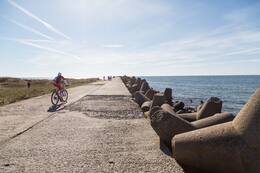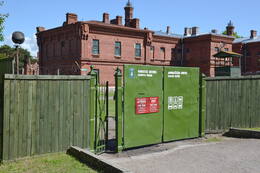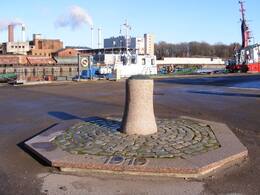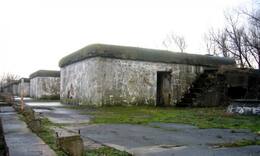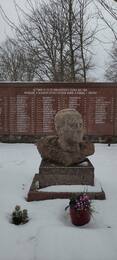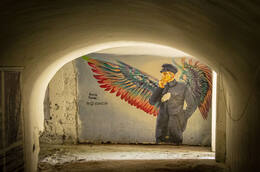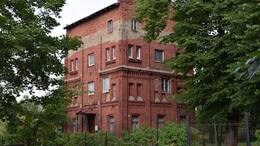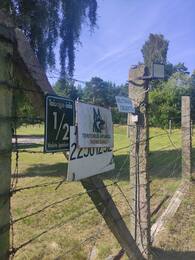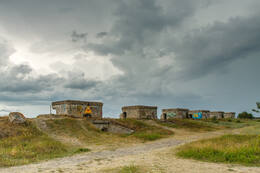Liepojos jūrų tvirtovė I WW1
Tvirtovė buvo pastatyta XIX amžiaus pabaigoje, XX amžiaus pradžioje, siekiant apsaugoti Liepojos karinio jūrų laivyno bazę potencialaus priešo puolimo atveju.
Įtvirtinimų sistema, kuri apėmė, pavyzdžiui, Redaną ir Šiaurinį fortą, supo visą miestą. Iš dalies į jūrą nuplauti šiauriniai fortai gali būti pavojingi lankytis.
Daugiau informacijos šaltinių
Liepojos istorijos vingiai: Liepojos tvirtovė (liepajasvesture.blogspot.com)
Susijusios vietos
Šiaurinis molas ir baterija Nr.3 Karostoje
Ilgiausias Latvijoje – Šiaurinis molas – pastatytas XIX amžiaus pabaigoje kaip labai svarbi Liepojos jūrų tvirtovės ir karinio uosto dalis. Prieplaukos ilgis – 1800 metrų, plotis – 7,35 metro.
Šiaurinis molas yra vienas iš pirmųjų imperatoriaus Aleksandro III uosto statinių, pastatytų 1890–1892 metais prieš Karostos kanalo kasimą. Kartu su Šiaurės molu, Pietų molu ir Pietiniu molas sudarė Liepojos forpostą.
Liepojos tvirtovės baterija Nr. 3 buvo įrengta šalia Karostos šiaurinio molo ir buvo planuojama būti didžiausia pagal ginkluotę. Platformos buvo pastatytos keturiems 6 colių (152 mm) 1892 metų modelio Canet sistemos pabūklams, penkiems 1887 metų modelio 11 colių (280 mm) pabūklams ir dviem 57 mm Nordenfeld prieštankiniams pabūklams, taip pat 18 9 colių (229 mm) pabūklų.
Šiandien 3 bateriją labiausiai paveikia vyraujanti pietų-šiaurės jūros srovė, kuri sukuria sūkurinį efektą už Šiaurės molo, dėl kurio išplaunami pabūklo platformos pamatai.
Šiaurinis molas saugo Liepojos uosto teritoriją nuo šiaurės vakarų vėjų. Tai Liepojos gyventojų ir lankytojų mėgstama vieta stebėti saulėlydžius, žvejoti ir stebėti jūrą įvairiomis oro sąlygomis. Ypač įspūdinga per audras.
Prie Šiaurės molo yra daug automobilių stovėjimo aikštelės. Taip pat yra tualetai ir kavinė su unikaliu vaizdu į jūrą.
Berth of the ship "Saratov" in Liepaja
The berth of the "Saratov" is located in Liepaja, at 59 Old Harbour, near the boat docks.
Built in 1888 in Copenhagen by the shipyard Buvmeistar & Wain under the name "Leopold II", in 1911 it was bought by the joint-stock company Russian North-West Shipping and renamed "Saratov", with the Latvian Aleksandrs Remess becoming the ship's captain.
In May 1915, when Liepaja was occupied by German troops, the Saratov was in a damaged state in the harbour.
On 10 January 1919, the steamship Saratov was taken over by the Latvian Provisional Government. From April to July 1919, after the "16 April coup d'état", the Provisional Government headed by K. Ulmanis was on board the Saratov and was forced to take refuge under the protection of the Allied fleet.
On 8 July 1919, after the delivery of the Provisional Government of K. Ulmanis to Riga, the steamers were used for traffic between Riga, Ventspils and Liepaja.
Under the terms of the Peace Treaty of 11 August 1920 between Latvia and Soviet Russia, the steamship Saratov had to be returned to the Soviet side. On 2 January 1923, the steamship was handed over to a Soviet Russian representative. On 15 January 1923, the steamship "Saratov" was wrecked off Akmenrags.
In 1936 the Latvian Maritime Department sold the wreck to a company, which scrapped it and handed it over to the Liepaja Cloth Factory.
Liepaja Fortress Battery No 6
The 6th Battery, which is the best preserved fortification structure today, was planned to protect the coast of Liepaja Fortress south of the Trade Canal. The battery was to house four 6-inch (152 mm) guns of the 1892 model of the Canet system, eight 11-inch (280 mm) guns of the 1887 model, nine mortars of various calibres and two 57 mm Nordenfeld anti-tank guns. At the beginning of the First World War, after the fortress had already been dismantled, Battery 6 still contained the armament used in April 1915, when the German Navy attempted to land a landing at the South Pier.
In the early 1920s, the construction of the Olympia Stadium, which can still be seen today, began on the battery site. The fortification ditch dug at the southern end of the battery is today included in the Liepāja Seafront Park.
Monument to the dead fishermen and sailors and US airmen
250 metres south-west of Battery 6 is the Monument to Fishermen and Sailors, with a plaque to the US Navy PB4Y-2 Privateer scout plane shot down off Liepaja on 8 April 1950. The aircraft, nicknamed Turbulent Turtle, was part of Patrol Squadron 26 and took off from Wiesbaden airfield in the early hours of 8 April and, via Copenhagen, set off on a surveillance and possibly radio reconnaissance mission. According to the order, the aircraft could not approach closer than 20 nautical miles to the Kurland coast, but for some unknown reason it flew into the USSR's self-defined 12 nautical mile zone. Two La-11s of the Soviet 30th Guards Fighter Regiment intercepted and shot down the unarmed reconnaissance aircraft. The fate of the 10-strong crew of the downed aircraft is not known with certainty; there is conflicting information that all were killed or, alternatively, that some of the pilots survived and ended up in prisoner-of-war camps.
The crew:
AT1 Frank L. Beckman
AL3 Joseph J. Bourassa
ENS Tommy L. Burgess
AD 1 Joseph H. Danens
LT John H. Fette
CT3 Edward J. Purcell
LTJG Robert D. Reynolds
AN Joseph N. Rinnier
LT Howard W. Seeschaf
AD 1 Jack W. Thomas
Liepaja Fortress South Fort and monument to N. Dedaev, commander of the 67th Rifle Division of the Red Army
The South Fort of Liepaja Fortress is located in the south-western part of Liepaja, between Klaipėda Street and the beach.
A fort was planned to protect the port of Emperor Alexander III from the south, two kilometres from the southern border of the city. The fort was to be located between Liepāja Lake and the sea, west of the outlet of the Thunder River, reinforcing the reinforced concrete fortifications with a moat. Although the fortifications were almost completely finished, the armaments had not been deployed. The constructed cellars were used as storage facilities both during the First World War and during the Second World War. In the 1920s and 1930s, various factories were located in the fortification area. Unlike the Middle Fort and Ravelin, the South Fort never took part in the war, because in all the wars the invaders besieged the eastern shore of Lake Liepāja and tried to invade Liepāja between Lakes Tosmare and Liepāja.
To the north of the South Fort is Liepāja's largest cemetery, the Central Cemetery. In the southern part of the cemetery there is a Red Army cemetery where Soviet soldiers who died in the vicinity of Liepāja are reburied, including the commander of the 67th Rifle Division, Major General Nikolai Dedaev, who led the defence of Liepāja in June 1941.
Redanas, Karosta
Redanas, arba Redanos fortas, yra Karostoje, lapkričio 14 d. gatvėje, apie 1,5 km nuo Šiaurinių fortų, gamtos rezervate „Tosmare“.
Istoriškai redanai buvo įtvirtinimų elementai, kur ilgesnės tvirtovės sienų atkarpos buvo dalijamos į trumpesnes dalis, įrengiant V formos pozicijas, nukreiptas į priešą, taip geriau apsaugant įtvirtinimų sieną. Karosto redanas yra XIX a. pabaigos Liepojos jūros tvirtovė, išsikišusi link Tosmarės ežero. Tvirtovei praradus savo, kaip tvirtovės, vaidmenį, aplink ją esantys įtvirtinimai ir fortai buvo iš dalies susprogdinti ir paversti nebenaudotinais. Tačiau Redanas išliko beveik nepaliestas.
1919 m. lapkritį, po nesėkmės Rygoje, Pavelo-Bermonto Avalovo pajėgos pradėjo intensyvų Liepojos puolimą. Mūšis vyko ir Redane, kur kovojo 80 Liepojos karinio uosto komendantūros kareivių, vadovaujamų vado leitenanto Radzinio. Lapkričio 14 d. per greitą puolimą bermontininkams pavyko užimti Redaną. Po to sekė Latvijos kariuomenės kontrataka ir Redanas buvo atsiimtas.
Birželio, liepos ir rugpjūčio mėnesiais kiekvieną dieną nuo 11.00 iki 17.00 val. Redane jūsų lauks patyręs gidas, pasiruošęs papasakoti daugiau apie Liepojos tvirtovę ir istorinius įvykius Karostoje.
Pigeon post sea station in Karosta
The former naval pigeon station No.2 - actually a breeding station - is located in Karosta, Pulkveža Brieža iela 6. It was built between 1899 and 1900 and was intended to house about 450 carrier pigeons - winged soldiers. In later years, the building was converted into apartments, so that only the red brick volume of the building remains. The other post pigeon station, No 1, which has not survived, was intended for the use of 750 ground troops and was located at the northern end of Atmodas Boulevard.
The carrier pigeons were a simple, fast and reliable way to ensure communication between the shore and ships at sea. Although the radio telegraph, as a modern communication device, was already widely used at that time, the use of pigeons was considered safer - an enemy could only intercept a message by intercepting the carrier pigeon itself. The carrier pigeons moved at an average speed of 60 km per hour, but in favourable wind conditions they could move at speeds of up to 100 km per hour. Pigeons had to be specially prepared and trained, so handling them required care and patience. The homing pigeon's communication worked through the birds' ability to return to their home cage. When the bird was transferred to another location - a pigeon station, release and release point - and released with a message capsule, the little messenger returned to its home cage. In order to ensure communication between the two pigeon stations, it was necessary to keep a certain number of birds in each, which had grown up in the correspondent's communication, or carrier pigeon, station. Each year the pigeons were involved in various manoeuvres and competitions. Also after Latvia's independence, from 1920 to 1940, an army carrier pigeon station was located in Liepāja for the Latvian Army's Courland Division, which was able to communicate with both Riga and Daugavpils. During the inter-war period, stray communication pigeons from Germany, Poland, Lithuania, Finland and Estonia also wandered into Latvian territory. Pigeons from Latvia were also suddenly found in neighbouring countries.
The building has been rebuilt several times over the years and is now a residential building. But the distinctive shape of the building, made of the red bricks characteristic of the old buildings of the Karosta, is still clearly visible from the outside.
Liepāja coastal artillery battery No. 2
Among the many objects of Liepāja Karosta, Liepāja coastal artillery battery No. 2 is still the most mysterious place in Liepaja. In battery no. 2, the ammunition depots of the troops of the various existing powers were always installed.
Liepaja Fortress Battery No. 2 was built further from the coastline and was protected by a high rampart. The batteries were armed with 16 11-inch (280 mm) mortars of the 1877 model. After the fortress was dismantled, ammunition warehouses were set up here. Due to the danger of explosions, the territory was closed to the public and guarded for 130 years, but now there is an exposition about the activities of the 1st Kurzeme Division Headquarters in the years 1919-1940s, as well as photo evidence of the 1st Liepāja Infantry Regiment, the 2nd Ventspils Infantry Regiment and the Kurzeme Artillery. regiment.
Liepāja Northern Fort and Battery Nr.1 in Karosta
The Northern Forts are the best known and visually most impressive part of the Liepāja Fortress. Built by the Russian tsarist army in the late 19th century, their historical name is Fortress Battery No 1.
In November 1908, less than 10 years after its construction, the Liepāja Fortress ceased to operate, because its construction was acknowledged as a strategic mistake. Some of the cannons were dismantled and taken to the Kaunas Fortress in Lithuania, while others were remelted. Fortification structures were detonated twice in an attempt to destroy the fortifications. Elements surviving to the present day include artillery batteries not fully destroyed in the explosions and underground structures. Just like the Karosta, the Northern Forts were a closed military territory during the Soviet occupation. Visitors to the Northern Forts should be very careful. As in other places on the Latvian coast, the steep shore of the Baltic Sea in the Karosta is dangerous due to potential coastal landslides. Therefore, it is not allowed to walk under the ruins of the forts.
In the northern part of the fortress was located one of the four coastal defence batteries, Battery No.1. The battery was to house six 6-inch (152 mm) guns of the 1892 model of the Canet system, six 11-inch (280 mm) guns of the 1887 model and two 57 mm Nordenfeld anti-ship guns. Only the guns of the Canet system had a long enough firing range to withstand possible shelling by the German Navy. Thus, at the time of the liquidation of the fortress, the armament was only partially installed.
Susijusi istorija
Sovietų aviacijos antskrydžiai Liepojos priemiestyje 1944 m. spalio ir gruodžio mėn
Pasibaigus Antrajam pasauliniam karui, vokiečių pajėgos Kurlande galėjo sėkmingai gintis septynis mėnesius, nes Vokietijos karinis jūrų laivynas išlaikė kovinį pajėgumą iki Antrojo pasaulinio karo pabaigos ir aprūpino Šiaurės armijos grupę, o vėliau Kurlando armijos grupę. Pagrindinis uostas buvo Liepoja, per kurį buvo pristatyta ir išgabenta 80% visų krovinių. Taip Liepoja tapo svarbiu sovietinio Baltijos laivyno ir tolimojo nuotolio aviacijos taikiniu.
Generolo majoro N. Dedajevo sužalojimas Liepojos tvirtovėje, Vidaus forte
1941 m. birželį sėkmingas vokiečių kariuomenės puolimas buvo pasiekęs Liepoją, kai Liepoją užpuolė Vokietijos šarvuotųjų pajėgų 291-oji pėstininkų divizija. 1941 m. birželį prasidėjus karo veiksmams tarp nacistinės Vokietijos ir Sovietų Sąjungos, sovietų armijos Liepojos garnizoną sudarė karinio jūrų laivyno ir Raudonosios armijos Liepojos karinės jūrų bazės kariai. Šių kautynių metu buvo mirtinai sužeistas generolas majoras N.Dedajevas
Redano mūšis 1919 m. lapkritį
Donāts Pudulis buvo Liepojos karo uosto komendantūras seržantas, gavęs Bulgės mūšio ordiną už narsą ir narsumą 1919 m. lapkričio 14 d., kai priešui užpuolus Redano fortą, perėmė komendantūros kuopos vadovavimą iš mirtinai sužeisto Radžinio dvarininko leitenanto ir komtūro leitenanto Robertas drofveta. priešas iš forto, paėmęs 8 belaisvius ir 2 veikiančius kulkosvaidžius. Įdomus jo gyvenimas iki Liepojos mūšio. 1911 m., būdamas 16 metų, savanoriu įstojo į Sibiro šaulių pulką. 1914 m. dalyvavo mūšiuose su vokiečių kariuomene Varšuvoje, Lodzėje ir kitur Lenkijos fronte, vėliau – mūšiuose su Austrijos kariuomene. 1915 m. jis išplaukė į Prancūziją per Vladivostoką kaip Rusijos ekspedicinio korpuso dalis ir 4 mėnesius kovojo Verdūne. 1917 m. pradžioje įstojo į latvių šaulių pulkus, o 1919 m. balandžio 7 d. – į Latvijos ginkluotąsias pajėgas Liepojoje.
Sparnuotieji kariai
XX amžiaus pradžioje buvo plačiai naudojama komunikacijos priemonė pašto karveliais arba pašto karveliais.
Karosta – vokiško He-111 nusileidimo vieta Liepojos paplūdimyje 1939 m
1939 m. rugsėjo 11 d. vokiečių bombonešis Henkel He-111 puolė Lenkijos miestus, kai naktį nukrypo nuo kurso ir avariniu būdu nusileido Liepojos paplūdimyje. Apie šį įvykį pasakojama Liepojos gyventojo, Kuržemės skyriaus ryšių kuopos pareigūno Vilio Zobenso atsiminimuose. Nusileidimo vieta gamtoje nepažymėta. Apytikslės koordinatės yra N 56.59368° E 21.01598° – paplūdimyje prie šiaurinių fortų.
Vilio Narkevičiaus kovinės veiklos aprašymas 1919 m. lapkričio 6 d
Būrio vado, vado leitenanto Juliaus Rozentalio Vilio Narkevičiaus kovinės veiklos aprašas, 1921 m. lapkričio 3 d.
Priežastys, dėl kurių apdovanojimas buvo suteiktas šarvuočio vadui A.Klestrovui
Sėkmingai atremęs priešo puolimą, ginkluoto traukinio vadas A.Klestrovas krenta ir pulkininkas Dankeris išdavė pagrindą apdovanojimui gauti.






